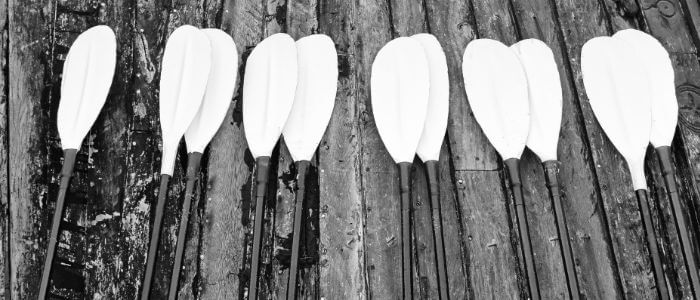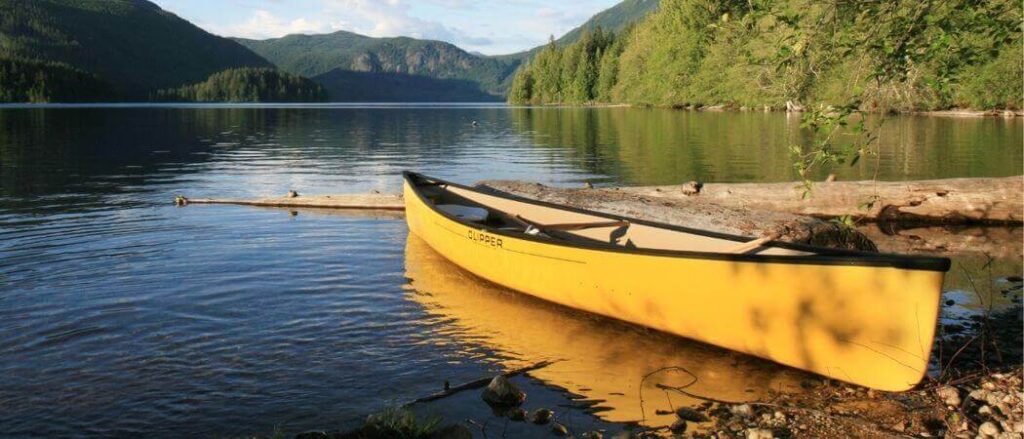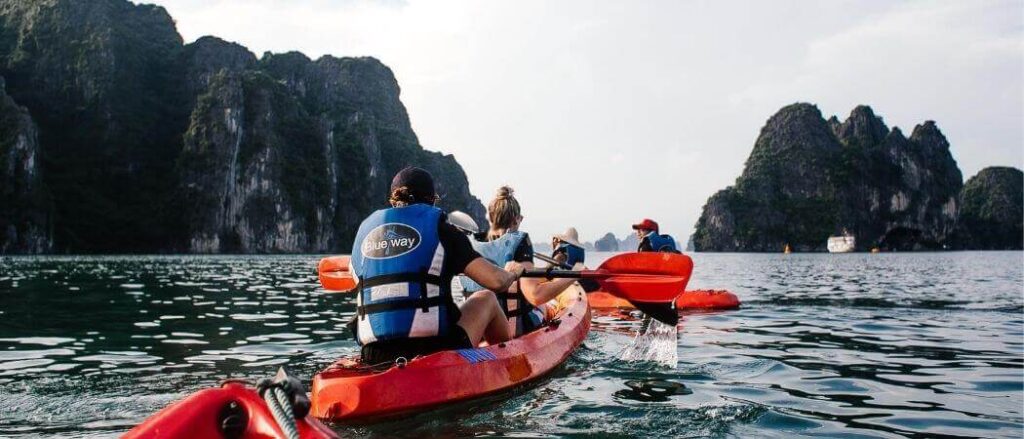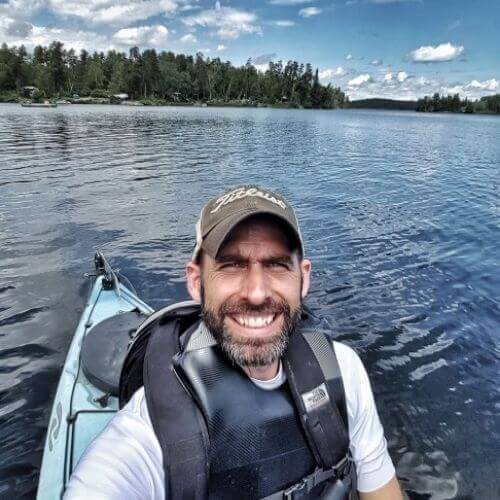
Canoe vs Kayak is one of the most discussed topics among paddlers around the globe. If you are new to paddling, it can be a bit confusing to figure out which boat is right for you. Canoes and kayaks are great choices for paddling enthusiasts, but they offer different benefits and are used in different situations.
So, let’s compare both of them in detail and know which one is better.
Following are some major differences between Canoes vs Kayaks that you should know if you’re deciding to go riding in the water without a motorized boat or water vehicle.

Canoes are typically larger and heavier than kayaks, requiring more energy to paddle. However, they can also hold more people than a kayak. That is why canoe paddles are longer and wider than those used on kayaks.
On the other hand, a kayak is smaller than a canoe and much lighter. It’s made for moving through rivers or lakes with ease. You can move through rapids without getting stuck on rocks or logs because of their maneuverability.
Canoes have more storage space than kayaks because canoes are longer and wider than kayaks. The Canoe’s length, width, and volume are larger than a kayak, which means that the Canoe can hold more gear and people.
Kayaks typically do not feature any kind of storage space except for a small hatch located on top of the boat used to store items such as food and water bottles.
As a result, canoes are more versatile than kayaks and ideal for carrying larger loads.
The open-deck design of a canoe allows you to enter and exit the boat without stepping on or over anything. This is particularly useful if you are traveling with children or pets, as it helps keep them safe and secure while you are on your trip.
On the other hand, Kayaks are closed-deck boats that require you to step on a particular side before getting in and out. If you are not careful, this can be dangerous. There’s a risk of falling into the water while trying to get into your kayak.
Canoes are more affordable than kayaks because they are easier to make and require fewer materials. Canoes use a single, long hollowed-out log, while kayaks use two or three pieces of different materials. This means that canoes are much easier to construct than kayaks.
In addition, canoes are made out of wood, while kayaks are constructed from plastic or fiberglass and foam. While this may not seem like it would make that much of a price difference, it actually does: wood is cheaper than the materials used in making kayaks.
So, if you are short on budget, the best decision would be to buy a canoe for yourself.
Canoes are generally better for a group of people and long trips, while kayaks are better for shorter trips and solo adventures.
Canoes can hold up to four people comfortably, which is great if you are going on an overnight camping trip or have kids who want to go with you. They also tend to be more stable than kayaks, so they might be a better choice if you are worried about tipping over or getting seasick.
On the other hand, kayaks can hold up to two people comfortably, which is good for short trips to have some fun with your partner. But, if you are going on a long trip, you can’t enjoy being on the waters while riding a kayak.
So, Canoes are better for longer trips for a group of people.

Kayaks are more streamlined than canoes, which has everything to do with speed.
The shape of a kayak allows for a longer hull and greater volume, which means you will get through the water faster. The shape also makes it easier to paddle out into the current, which means that you can make your way upstream or downstream more efficiently.
On the other hand, Canoes are flat-bottomed, making them more stable in the water and less efficient at moving through it. This means that you can’t travel faster on Canoe than on a kayak.
So, if you are looking for a fast boat that can help you quickly explore the area, you require a good kayak.
As mentioned above, the primary difference between a canoe and a kayak is their size. Canoes typically range from 16 to 17 feet long, while kayaks tend to be about 11 feet long. This can vary greatly based on the type of kayak you are looking at and your needs.
The smaller size of kayaks makes them much easier to maneuver than canoes, which tend to be heavier and more difficult to turn on a dime. This makes it much easier for beginners to learn how to paddle a kayak, especially since they are more compact, so they don’t require as much space as canoes do when moving them around in the water.
Kayaks have the advantage of solo paddling because they’re easier to maneuver and don’t require a partner.
Canoes are large, cumbersome vessels that can be difficult to control. The best way to travel in a canoe is with a friend or two who can help balance it and steer. But kayaks are specifically designed for solo paddling; they are more stable than canoes, so you can go farther without falling out of your boat.
So, Kayaks have the advantage of being faster, stable, and more maneuverable than canoes. This makes them ideal for people who want to paddle alone.
Kayaks are easier to transport than canoes because they are smaller, so they are less hassle to move around. Canoes are longer and wider than kayaks, which means they take up more space in the car when you are transporting them.
Canoes are typically made of wood, while kayaks are usually fiberglass or other composite materials. That is why canoes weigh more than a kayak, making them difficult to transport or move around.
A kayak is easier to store than a canoe because it’s smaller and weighs less.
The size of your boat is one of the most important factors in how easy it will be to store it. The shorter and narrower your boat, the easier it will be to find space for it in your garage or basement. That is why kayak is easier to store.
Canoes are longer and heavier than kayaks, making them harder to store. Canoes are also more difficult to transport because they cannot be folded up, unlike kayaks.
So, if you are looking for a boat that you can easily store in your garage or basement area, go for a kayak, as they are lightweight and easy to store compared to canoes.
Canoes and kayaks are both great boats, but they have their differences.
The differences mentioned above state that Canoes and Kayaks are different in so many ways, so they are suitable for different people. Anyone can’t state that one is better than the other because both have their own pros and cons. But, if you need a small, compact, and easy-to-ride boat, kayaks are best for you.
On the other hand, Canoes are heavy and difficult to carry around. Hence, if you want to go camping with a group of people, then Canoes will be the best choice.
Here are some common questions that people ask about Canoe Vs Kayak.
You might think that canoes are faster than kayaks, but they’re not.
Canoes aren’t faster than kayaks because they are large, and it’s hard to take turns on Canoe. On the other hand, kayaks are smaller in size, which is why they are easy to turn around.
Canoes are also heavy and rigid, making it hard to maneuver them around. They also require more effort than kayaks when paddling.
The primary difference between canoes and kayaks is that kayaks sit lower in the water, making them easier to maneuver through rapids and other obstacles such as rocks or logs that may be floating in the waterway.
Canoes sit higher up out of the water, making them slower and providing more stability when paddling over rough waters.
It depends on what you are doing with your vessel, who’s riding in it, and how you are using it.
Canoes and kayaks are two of the most popular vessels for water sports. Both are designed to be stable, and both are often used for fishing and recreational paddling.
In general, canoes tend to be more stable than kayaks because they have a wider bottom, which helps them stay upright when paddling by more than one person or when there’s more weight in the boat.
On the other hand, kayak stability is largely dependent on its design; some kayaks have greater stability than others, depending on their shape and size.
So, we can say that canoes are more stable than kayaks in general. A canoe provides more room to sit in than a kayak, and it’s less likely to tip over. However, canoes aren’t as fast as kayaks, taking up more space to store.
The answer to this question depends on the type of Canoe or kayak you are using. If you are paddling in a sit-on-top kayak, then you will be able to stand up in the boat and paddle it with your hands. On the other hand, if you are paddling in a sit-in kayak, you most likely won’t be able to stand up while paddling.
On the other hand, you can sit and stand on any kind of Canoe as they are more stable and less likely to flip over.
Standing up might be a good idea if you are just going for a leisurely paddle around the lake and want to get a good view of the landscape. This way, you can see more than just the water surrounding you and enjoy your surroundings and the exercise.
Similarly, sitting might be better if you are going on an intense fishing trip or hunting expedition. It will make it easier to keep your balance when maneuvering through rapids or other obstacles in the water.
The average Canoe can hold about 1-3 people, but this is only if you use a canoe and not a kayak. Canoes are more stable than kayaks and, therefore, good for families with kids, but they also take up more space.
On the other hand, kayaks are more maneuverable, but they don’t hold as many people or gear. Most kayaks can hold around 1-2 people, while some can hold up to 3 passengers.
The truth is that the decision to use either a canoe or kayak depends on many factors, including your ability level, where you plan to fish, and what kind of fishing you plan to do. The best way to decide which one is right for you is to start by considering what kind of fish you want to catch.
If you’re looking for large fish, then a canoe may be the way to go. Canoes are long and wide, which means they can hold more gear than a kayak and have more space for standing up (if needed). They also have more stability than a kayak, making them easier to paddle when loaded with gear and passengers. On the other hand, canoes are hard to maneuver in tight spaces like creeks or rivers with rapids.
Kayaks are much more maneuverable than canoes, but there’s less room for gear and passengers unless you purchase an inflatable kayak. Because of their small size and weight capacity limits, kayaks may not be ideal for fishing, especially when you need to catch big fish and load them onto your kayak.
Canoes and kayaks are both great for solo or tandem use. They are both stable, so you can be sure that you will have a safe ride. They are also easy to paddle, so you can get your workout in a while enjoying the scenery.
However, there are some differences between canoes and kayaks that might make one more suitable for your needs than the other.
For example, canoes tend to be longer than kayaks and therefore heavier. This means they are better suited for tandem use than kayaks, which typically only seat one or two people.
Canoes also offer more storage space than kayaks because they have bulkheads (the sides of the boat that contain compartments) that allow you to store items on board without them getting wet if you capsize.
On the other hand, kayaks are faster than canoes because they don’t have bulkheads holding them back. They are just one continuous piece of material stretched across a frame made from aluminum or carbon fiber (which makes them lighter). Also, if you want a solo experience but still need space for gear or supplies, then a canoe won’t work because it’s too large for just one person.
Both canoeing and Kayaking are fun, healthy ways to get out on the water. They’re also both fairly easy to learn! But which one is right for you?
The main difference between canoeing and Kayaking is that with canoeing, you sit on a bench in the middle of the boat, while with Kayaking, you sit in a seat at the front or center of the boat. Both canoes and kayaks have one or two people paddling them at once, so there are other differences to consider if you are going solo.
First off: Canoeing can be more difficult if you don’t have someone else to help paddle with you because it requires more strength than Kayaking. On top of this, canoes can be harder for teenagers because they will need to be able to lift their legs up high enough to get into them without tipping over or falling into the water.
In terms of safety: Because kayaks sit lower in the water than canoes do and therefore take less effort to maneuver, they tend to be safer for beginners who don’t want to fall out as easily as they could with a canoe.
That is why Kayaking is easier and more fun to learn than canoeing.
Here are some tips to help you stay safe while on your Canoe or Kayak.
Wearing a life jacket is not only the law; it’s also the best way to stay safe while on the water. Life jackets are designed to keep you afloat in case of an emergency and to keep your head above water in an accident or fall.
They are made of material that will stay dry and comfortable even if it gets wet, so you can wear them for hours without feeling uncomfortable.
Always dress according to the water temperature. Even if you are going on a canoe or kayak trip in the summer and it’s hot out, the water will still be cold. It’s important to dress appropriately. Choose layered clothing that keeps you warm and dry but allows you to shed layers as you get hotter.
You will also have to make sure you have a hat and sunglasses on hand to protect your head and eyes from the sun.
Having a clean boat is the best way to stay safe while on the water. The cleanliness of your boat will help you avoid getting infections, and it will also keep it from becoming damaged by dirt, insects, and other environmental factors.
You should wash your boat after every use, or at least once a week if you use it regularly. Use soap and water to wash off any mud or dirt accumulated during your trip.
Avoid straying into deep waters. While you may feel like you have plenty of time to paddle to shore, you should always ensure that your route back is clear before going too far from land.
If you find yourself in deep water, try to stay calm and use your paddle to keep yourself afloat until help arrives.
It’s also important to ensure that you don’t tip over in shallow waters. It can be difficult to get back into the boat and onto your feet if you do. It also makes it hard for other boaters to see what is going on with you.
Instead, keep yourself upright when paddling through shallow water by using your paddle as a rudder and keeping your body low. This will help keep the Canoe or kayak from tipping over onto its side and allow the boat to pass by safely.
Canoe vs Kayak is a very common argument. Many people think that Canoe is better, while other people think kayak is far better than canoes. So, it’s a never-ending debate, but the truth is both canoes and kayaks are good in their own ways.
Kayak is good for short trips on calm and easy waters, while Canoe is suitable for long trips into wild water. Besides, if you are looking to have a suitable vessel that you can easily control and store in your house, then you should go for the kayak because canoes are large and difficult to store.

Hey there kayak lovers! I’m Jay Schwartz, the author here at Kayak Guidance! You know water sports – you know me! My life is all about it. Kayaking, Paddleboarding, Fishing, Snorkeling and so much more. I love to share my passion and knowledge with all of you.

Hey there kayak lovers! I’m Jay Schwartz, the author here at Kayak Guidance! You know water sports – you know me! My life is all about it. Kayaking, Paddleboarding, Fishing, Snorkeling and so much more. I love to share my passion and knowledge with all of you.

Welcome to KayakGuidance.com! If you’re looking to have some fun outdoor water adventures, then you have come to the right place. We help our readers find the best kayaks and water related equipment to help you have the best time of your life whenever you are engaging in water activities.
This site is a participant in the Amazon services LLC associates program, an affiliate advertising program designed to provide a means for sites to earn advertising fees by advertising and linking to Amazon.com.